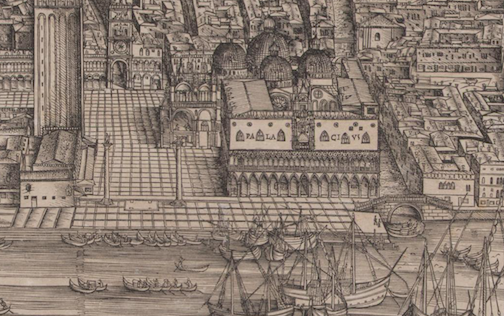Italy
Jacopo de’ Barbari, View of Venice (detail), 1500. Woodcut print. Minneapolis Institute of Art, Minnesota.
Venetians and Genoese merchants were the leading importers of slaves into Italy.[11] Enslaved people in Italy in these centuries came from almost every ethnic group known at the time, including Circassians, Georgians, Jews Abkhazians from the Black Sea region, North African Moors and sub-Saharan blacks, people from the Canaries, and Cape Verde Islands.[12] While certain towns such as Palermo used slaves for rural agricultural labor, for others they were prestigious luxury items symbolic of their owners’ elite status. Edelgard E. DuBruck and Even Yael found that there was a high demand for Black slaves since they were scarce by the late fifteenth century. Because of this need for Black slaves, in result, they became very expensive; hence they were only found in the households of wealthy members of court culture. They also note that young Black children were purchased for pleasure and amusement, which will be explained later.[13] There was a large disparity in the function of Black African male and female slaves: indeed, male owners typically used younger female slaves for sex.[14] Since there was an imbalance of male to female slaves, with slaves being overwhelmingly female, breeding slaves was not a priority for Italians as it was for others.[15] Some children conceived by enslaved women could inherit the social status of their white fathers, yet most were unacknowledged and abandoned by their white fathers. In one example of this practice, a man by the name of Pietro Porco, residing in Venice, attempted to sell two young boys, Dimitrios and Andronicos, in 1345. In court it emerged that Pietro was himself their father and because he tried to sell his own children, the court ruling was to set them free.[16] It is quoted here in the court ruling, “[Pietro] may in no way or manner sell or alienate one or both of them at any time. They are and will remain in perpetuity free, since the regime has accepted on the strength of worthy witnesses who testified under oath not only that Dimitrios and Andronicos were the spurious sons of Pietro, who begat them with Theodora [mother], but also that he had treated them as sons of that condition, and had acknowledged them to be his spurious sons.”[17] A large number of abandoned slave women’s children in the foundling hospitals of those cities gives a good idea of how widespread master-slave sexual relations were. This situation suggests that few children were lucky enough to have a father who acknowledged them and many of which were thrown into orphanages or sold off by wives of the male owners after their deaths.[18] On the other hand, slavery could be short-lived, for at the death of an enslaver, an enslaved person was either free to go or their ownership was extended for a finite period.[19] Yet even after they became free, ex-slaves were still not equal in society, for often they had no choice but to turn to prostitution or theft, which made them subject to criminal activity.[20]
Venice was more ethnically and racially diverse than other cities in Italy, and more tolerant of diversity among its populations, yet references to enslaved people from the sub-Sahara regions appear with relative frequency in city records in the second half of the fifteenth century when domestic slavery in Italy was otherwise in decline.[21] Travelers to Venice described seeing bands of young men and women, often shackled around the neck or legs, herded together on shorelines, waiting to be loaded on to vessels.[22] Petrarch described the enslaved persons he observed as having caked hair, rough faces, and grass stuck in their teeth, a description that Sally McKee concluded was typical of the ways that privileged people conceptualized those they considered beneath them on a social hierarchy constructed around skin tone.[23] Such prejudices were grounded in part in religion, since many Black Africans were not practitioners of the dominate religion of Christianity, but rather they were Muslims. The term used by Italians Moor or moro, initially described people who were Muslim or African, but later was used exclusively to describe someone of African descent.

